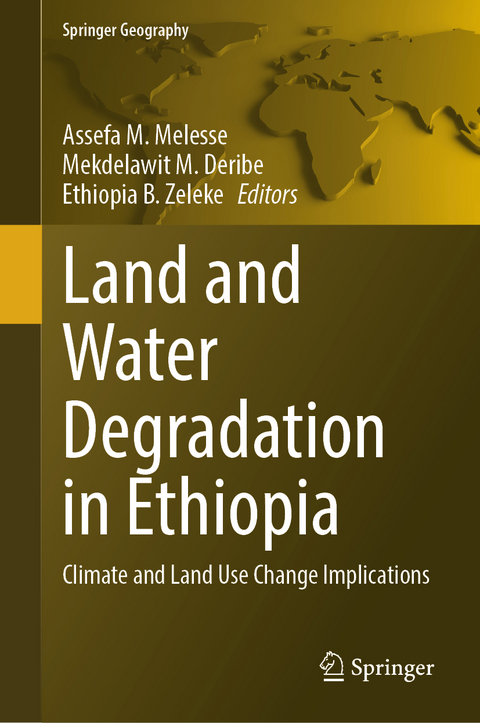
Land and Water Degradation in Ethiopia
Springer International Publishing (Verlag)
978-3-031-60250-4 (ISBN)
Water is life for all human beings and is essential for sustainable economic development. Access to freshwater is a fundamental human right. Ensuring access to safe drinking water and sanitation is vital for economic growth, poverty reduction and enhancement of human well-being. Yet, uncertain global water availability compounded by factors such as climate change and land degradation have made meeting the growing water demand a daunting task for many communities.
The world is facing an unprecedented climate crisis, intricately linked with water resources. We have witnessed frequent and intense hydrologic extremes (floods and droughts). In the past decade alone, floods, storms, droughts, and other weather-related events accounted for over 90% of natural disasters.
Water, being at the center of national policies of many countries, the impact of climate change on water resources extends across multiple sectors including energy production, food security, health, environmental conservation, and economic development. Research has shown that climate change has impacted the hydrologic cycle, affected the availability and predictability of water, and hence threatened the efforts of poverty reduction and economic development. These impacts are more pronounced in developing countries, exacerbating existing socioeconomic challenges, and hindering progress towards self-sufficiency in food, water, and energy production. The impact of climate change on these countries is further aggravated by land degradation, land use changes, unsustainable agricultural practices, poor watershed management and ecological degradation and loss of biodiversity.
This book aims to explore these issues, with chapters dedicated to examining land and water degradation, water quality, irrigation, groundwater management, land use dynamics and the impacts of climate change on freshwater resources in Ethiopia.
Understanding the effect of Land Use Land Cover (LULC) Dynamics on the stream flow.- Dynamics and Predictability of Land Use Land Cover Change using Artificial Neural Network.- The Contribution of Microbial Endophytes Associated with Climate Smart Brachiaria Grass Species.- Land Suitability Mapping for Surface Irrigation Using GIS Based Multicriteria Evaluation Techniques.- Exploring soil properties from spectrometry for better management in the Abbay River Basin.- Identifying Soil Erosion Hotspot Areas Using GIS and MCDA Techniques.- Soil Erosion Risk Assessment.- Channel Stability Assessment And Stabilization Measure Of Mersa River.- Effect of Climate Variability on Crop Diversity over the Agro Ecological Zones of Gumara Watershed.- Wind as a promising alternative energy source in Ethiopia.- Analysis of Climate Variability and Agricultural Drought and their Implications.- Developing a Multilinear Regression Water Consumption Model.- Effects of deficit irrigation and mulching on the water footprint of maize production.- Management of Transboundary Watercourse in Euphrates Tigris and Nile River Basins.- Geospatial based Groundwater Potential Zone Investigation and Mapping.- Evaluation of the Hydraulic Performance of the Kombolcha Town Water Supply Distribution System.- Assessment of Rooftop Rainwater Harvesting as an Alternative Source of Water Supply.- Dual Stage Solar Powered Electrocoagulation and Electrooxidation Process.- Hydrochemical Suitability of High Discharge Springs for Domestic and Irrigation purposes.
| Erscheinungsdatum | 06.08.2024 |
|---|---|
| Reihe/Serie | Springer Geography |
| Zusatzinfo | IX, 503 p. 157 illus., 142 illus. in color. |
| Verlagsort | Cham |
| Sprache | englisch |
| Maße | 155 x 235 mm |
| Themenwelt | Naturwissenschaften ► Geowissenschaften ► Geografie / Kartografie |
| Naturwissenschaften ► Geowissenschaften ► Hydrologie / Ozeanografie | |
| Naturwissenschaften ► Geowissenschaften ► Meteorologie / Klimatologie | |
| Schlagworte | Climate Change Impact • Droughts • land degradation • water quality • watershed modeling |
| ISBN-10 | 3-031-60250-1 / 3031602501 |
| ISBN-13 | 978-3-031-60250-4 / 9783031602504 |
| Zustand | Neuware |
| Haben Sie eine Frage zum Produkt? |
aus dem Bereich


